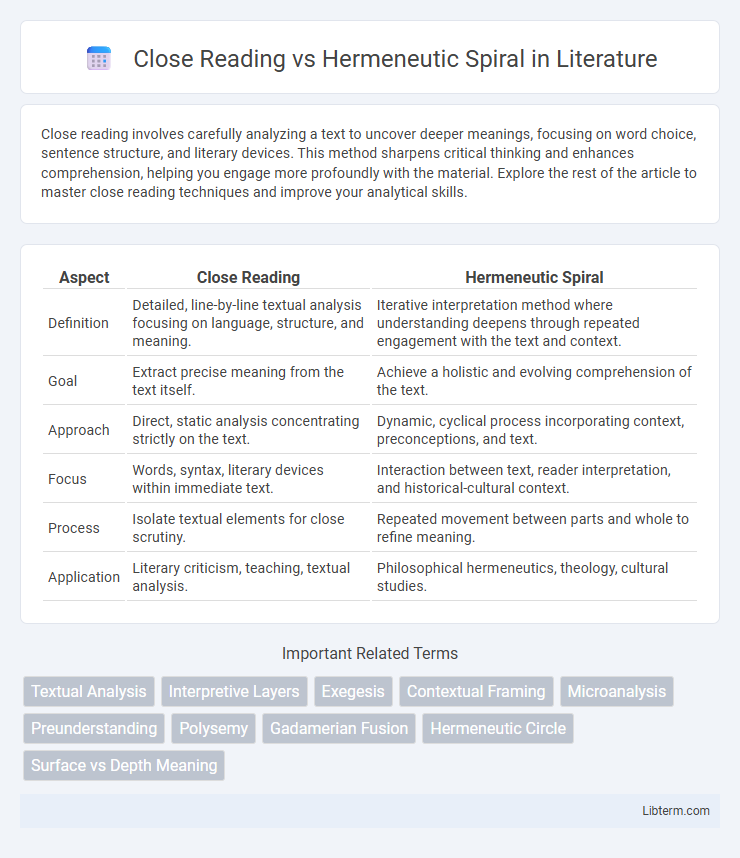Close reading involves carefully analyzing a text to uncover deeper meanings, focusing on word choice, sentence structure, and literary devices. This method sharpens critical thinking and enhances comprehension, helping you engage more profoundly with the material. Explore the rest of the article to master close reading techniques and improve your analytical skills.
Table of Comparison
| Aspect | Close Reading | Hermeneutic Spiral |
|---|---|---|
| Definition | Detailed, line-by-line textual analysis focusing on language, structure, and meaning. | Iterative interpretation method where understanding deepens through repeated engagement with the text and context. |
| Goal | Extract precise meaning from the text itself. | Achieve a holistic and evolving comprehension of the text. |
| Approach | Direct, static analysis concentrating strictly on the text. | Dynamic, cyclical process incorporating context, preconceptions, and text. |
| Focus | Words, syntax, literary devices within immediate text. | Interaction between text, reader interpretation, and historical-cultural context. |
| Process | Isolate textual elements for close scrutiny. | Repeated movement between parts and whole to refine meaning. |
| Application | Literary criticism, teaching, textual analysis. | Philosophical hermeneutics, theology, cultural studies. |
Introduction to Close Reading and Hermeneutic Spiral
Close reading involves a detailed, systematic analysis of a text, emphasizing attention to language, structure, and meaning to uncover deeper layers of interpretation. The hermeneutic spiral is a dynamic process in which understanding develops through the iterative movement between the parts of the text and the whole, allowing interpretations to evolve progressively. Both methods prioritize careful examination and interpretive engagement but differ in their approach, with close reading focusing on micro-level analysis and the hermeneutic spiral on the interplay between context and text.
Defining Close Reading: Origins and Principles
Close reading originated in the early 20th century, rooted in New Criticism, emphasizing meticulous analysis of texts to uncover meaning through detailed attention to language, structure, and literary devices. Its principles focus on interpreting the text itself, avoiding external contexts, and prioritizing ambiguity, irony, and paradox to deepen understanding. Close reading involves repeated, focused examinations of specific passages to reveal layers of significance within the text.
Understanding the Hermeneutic Spiral
The hermeneutic spiral advances understanding by emphasizing iterative interpretation, where each reading deepens insight into the text's meaning through continuous interaction between parts and the whole. Unlike close reading's detailed textual analysis focusing primarily on language and structure, the hermeneutic spiral incorporates context, preconceptions, and evolving perspectives to refine comprehension dynamically. This process reveals deeper layers of significance by constantly revising interpretations, enabling a more nuanced and holistic grasp of complex texts.
Historical Contexts of Textual Analysis
Close reading emphasizes meticulous examination of a text's language, structure, and literary devices to uncover nuanced meanings within its original historical context. The hermeneutic spiral involves iterative interpretation, where understanding deepens by continually revisiting the text alongside evolving historical and cultural contexts. Analyzing historical contexts in textual analysis ensures interpretations remain grounded in the socio-political and cultural conditions influencing the text's creation and reception.
Methodological Differences: Step-by-Step Comparison
Close Reading involves a meticulous, line-by-line analysis of a text's language, structure, and meaning, emphasizing attention to detail without moving beyond the text itself. The Hermeneutic Spiral method embraces an iterative process, where initial interpretations are continuously revised through cycles of understanding the parts and the whole, incorporating context and historical background. While Close Reading remains text-centered and static in scope, the Hermeneutic Spiral dynamically integrates evolving insights, aiming for deeper comprehension through recursive contextualization.
Depth of Interpretation: Surface vs Layered Meaning
Close reading emphasizes detailed examination of the text's language, focusing on surface-level nuances such as word choice, syntax, and imagery to uncover immediate meaning. The hermeneutic spiral approach involves iterative interpretation, cycling between understanding parts and whole to reveal layered meanings embedded in cultural and historical contexts. Depth of interpretation in close reading is often confined to textual intricacies, whereas the hermeneutic spiral seeks progressively deeper insights through continuous re-evaluation and expansion of understanding.
The Role of Reader and Text in Both Approaches
Close reading emphasizes meticulous analysis of the text itself, with the reader focusing on language, structure, and literary devices to uncover meaning embedded within the text's surface. The hermeneutic spiral involves an iterative process where the reader's understanding evolves through a dynamic interaction between the text and the reader's prior knowledge, continuously refining interpretation. In both approaches, the reader's active engagement is crucial, but close reading centers on textual details while the hermeneutic spiral highlights the evolving dialogue between reader and text.
Applications in Literary Criticism and Beyond
Close reading enhances literary criticism by enabling detailed textual analysis of language, imagery, and structure, revealing deeper meanings within a text. The hermeneutic spiral extends this approach through iterative interpretation, where understanding evolves by continuously revisiting the text and its contexts, influencing fields like theology and law. Both methods enrich critical inquiry, but close reading emphasizes micro-level textual focus, while the hermeneutic spiral integrates historical and cultural dimensions for holistic interpretation.
Strengths and Limitations of Each Method
Close reading excels in detailed textual analysis by emphasizing precise language, structure, and literary devices, fostering deep comprehension of the text itself without external influences. Its limitation lies in potential neglect of broader contexts such as historical, cultural, or authorial intentions, which can lead to narrow interpretations. The hermeneutic spiral strengthens understanding through iterative interpretation, integrating the text with context and reader experience, but this approach can introduce subjectivity and complexity, sometimes making definitive conclusions challenging.
Integrating Close Reading and Hermeneutic Spiral in Practice
Integrating Close Reading and the Hermeneutic Spiral in practice enhances textual analysis by combining detailed, line-by-line examination with iterative interpretation that considers broader contexts. Close Reading focuses on the precise language and structure, while the Hermeneutic Spiral encourages revisiting the text repeatedly to deepen understanding through evolving perspectives. This integration allows readers to refine interpretations continuously, balancing micro-level textual evidence with macro-level thematic insights for comprehensive meaning-making.
Close Reading Infographic

 libterm.com
libterm.com